Sainsbury's Organisational Behaviour Report: Culture, Power, Teams
VerifiedAdded on 2023/01/18
|17
|5137
|100
Report
AI Summary
This report provides a comprehensive analysis of Sainsbury's organizational behaviour, examining the interplay of culture, power, politics, and their impact on individual and team performance. The report delves into various cultural models like Handy's typology, assessing their relevance to Sainsbury's operations. It explores the influence of power dynamics, including reward, coercive, and expert power, on employee motivation and behavior. Furthermore, the report analyzes both content and process theories of motivation, such as ERG theory, to understand how Sainsbury can effectively motivate its workforce. It also differentiates between effective and ineffective teams, providing insights into team development theories and their impact on organizational success. The report concludes with an application of organizational behaviour concepts, offering recommendations for enhancing employee engagement and overall organizational effectiveness. The report is a valuable resource for students seeking to understand organizational behaviour principles through a real-world case study.
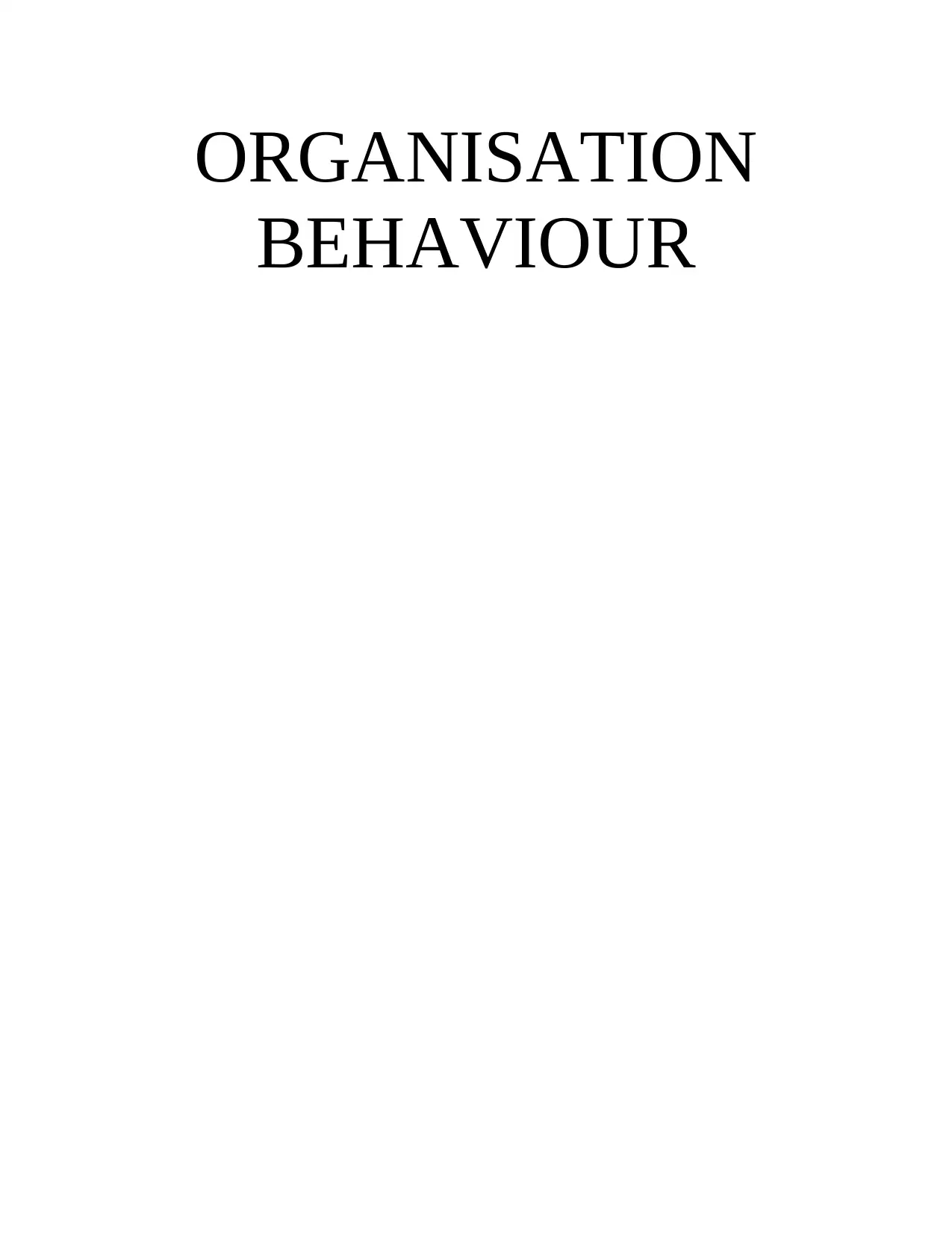
ORGANISATION
BEHAVIOUR
BEHAVIOUR
Paraphrase This Document
Need a fresh take? Get an instant paraphrase of this document with our AI Paraphraser
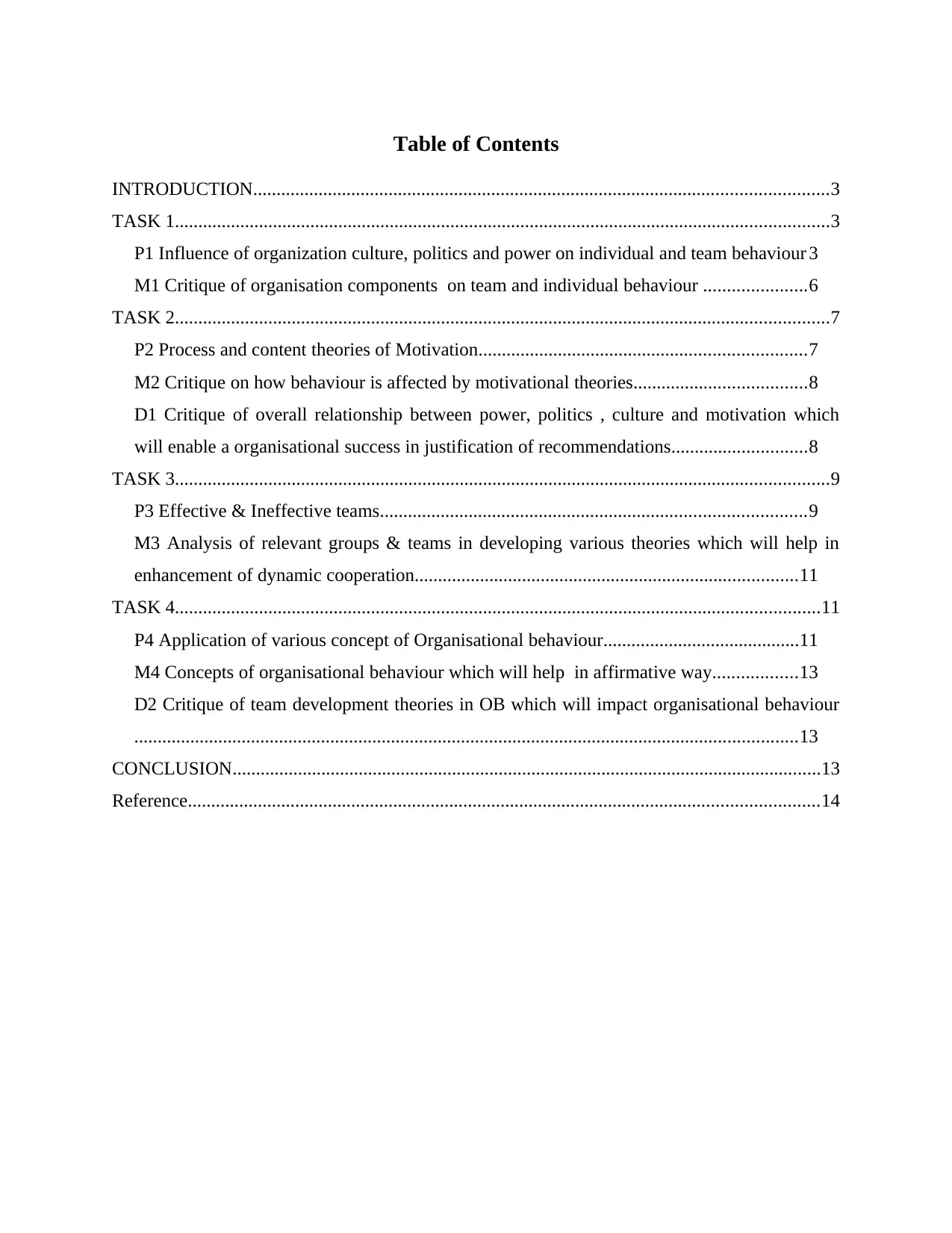
Table of Contents
INTRODUCTION...........................................................................................................................3
TASK 1............................................................................................................................................3
P1 Influence of organization culture, politics and power on individual and team behaviour 3
M1 Critique of organisation components on team and individual behaviour ......................6
TASK 2............................................................................................................................................7
P2 Process and content theories of Motivation......................................................................7
M2 Critique on how behaviour is affected by motivational theories.....................................8
D1 Critique of overall relationship between power, politics , culture and motivation which
will enable a organisational success in justification of recommendations.............................8
TASK 3............................................................................................................................................9
P3 Effective & Ineffective teams...........................................................................................9
M3 Analysis of relevant groups & teams in developing various theories which will help in
enhancement of dynamic cooperation..................................................................................11
TASK 4..........................................................................................................................................11
P4 Application of various concept of Organisational behaviour..........................................11
M4 Concepts of organisational behaviour which will help in affirmative way..................13
D2 Critique of team development theories in OB which will impact organisational behaviour
..............................................................................................................................................13
CONCLUSION..............................................................................................................................13
Reference.......................................................................................................................................14
INTRODUCTION...........................................................................................................................3
TASK 1............................................................................................................................................3
P1 Influence of organization culture, politics and power on individual and team behaviour 3
M1 Critique of organisation components on team and individual behaviour ......................6
TASK 2............................................................................................................................................7
P2 Process and content theories of Motivation......................................................................7
M2 Critique on how behaviour is affected by motivational theories.....................................8
D1 Critique of overall relationship between power, politics , culture and motivation which
will enable a organisational success in justification of recommendations.............................8
TASK 3............................................................................................................................................9
P3 Effective & Ineffective teams...........................................................................................9
M3 Analysis of relevant groups & teams in developing various theories which will help in
enhancement of dynamic cooperation..................................................................................11
TASK 4..........................................................................................................................................11
P4 Application of various concept of Organisational behaviour..........................................11
M4 Concepts of organisational behaviour which will help in affirmative way..................13
D2 Critique of team development theories in OB which will impact organisational behaviour
..............................................................................................................................................13
CONCLUSION..............................................................................................................................13
Reference.......................................................................................................................................14
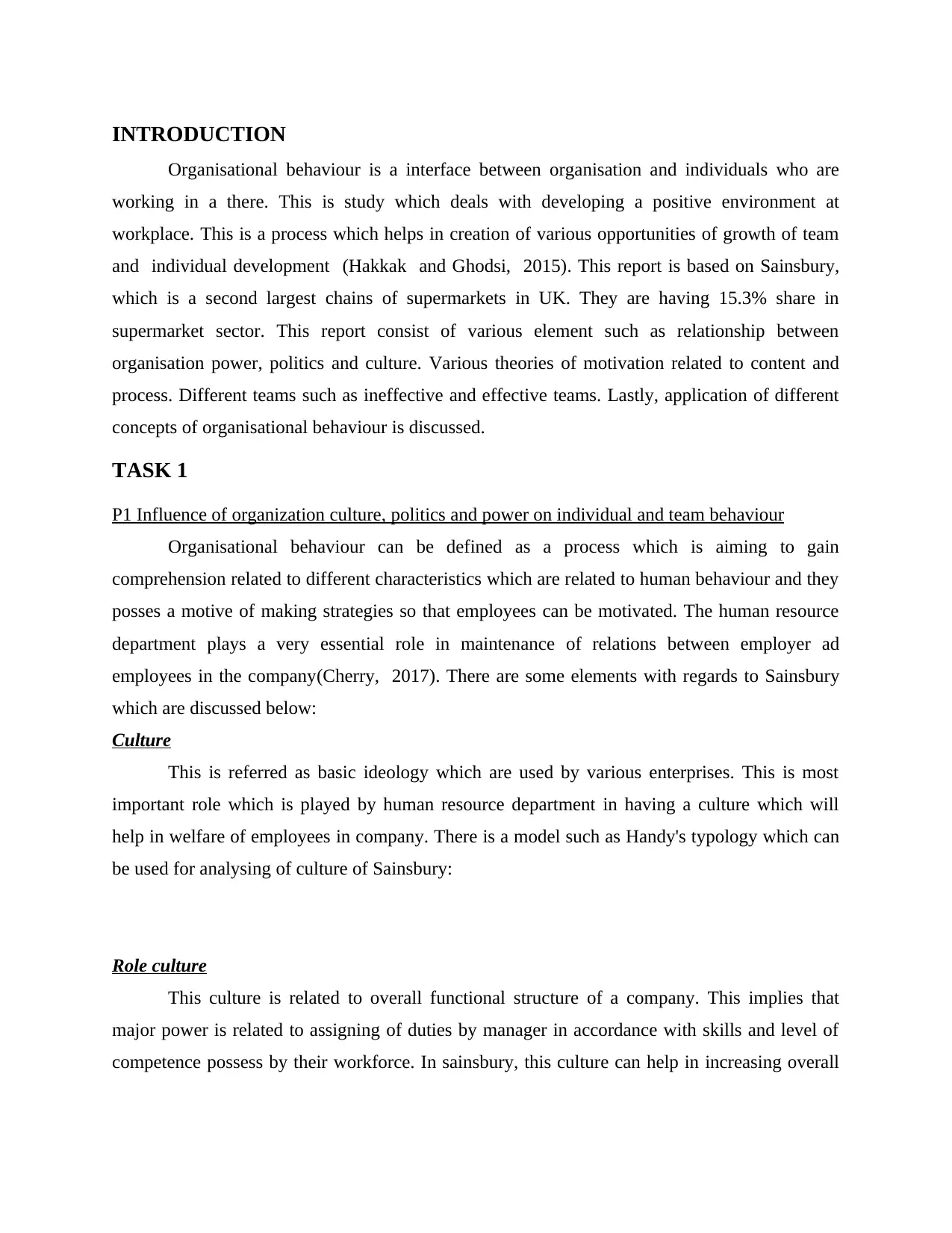
INTRODUCTION
Organisational behaviour is a interface between organisation and individuals who are
working in a there. This is study which deals with developing a positive environment at
workplace. This is a process which helps in creation of various opportunities of growth of team
and individual development (Hakkak and Ghodsi, 2015). This report is based on Sainsbury,
which is a second largest chains of supermarkets in UK. They are having 15.3% share in
supermarket sector. This report consist of various element such as relationship between
organisation power, politics and culture. Various theories of motivation related to content and
process. Different teams such as ineffective and effective teams. Lastly, application of different
concepts of organisational behaviour is discussed.
TASK 1
P1 Influence of organization culture, politics and power on individual and team behaviour
Organisational behaviour can be defined as a process which is aiming to gain
comprehension related to different characteristics which are related to human behaviour and they
posses a motive of making strategies so that employees can be motivated. The human resource
department plays a very essential role in maintenance of relations between employer ad
employees in the company(Cherry, 2017). There are some elements with regards to Sainsbury
which are discussed below:
Culture
This is referred as basic ideology which are used by various enterprises. This is most
important role which is played by human resource department in having a culture which will
help in welfare of employees in company. There is a model such as Handy's typology which can
be used for analysing of culture of Sainsbury:
Role culture
This culture is related to overall functional structure of a company. This implies that
major power is related to assigning of duties by manager in accordance with skills and level of
competence possess by their workforce. In sainsbury, this culture can help in increasing overall
Organisational behaviour is a interface between organisation and individuals who are
working in a there. This is study which deals with developing a positive environment at
workplace. This is a process which helps in creation of various opportunities of growth of team
and individual development (Hakkak and Ghodsi, 2015). This report is based on Sainsbury,
which is a second largest chains of supermarkets in UK. They are having 15.3% share in
supermarket sector. This report consist of various element such as relationship between
organisation power, politics and culture. Various theories of motivation related to content and
process. Different teams such as ineffective and effective teams. Lastly, application of different
concepts of organisational behaviour is discussed.
TASK 1
P1 Influence of organization culture, politics and power on individual and team behaviour
Organisational behaviour can be defined as a process which is aiming to gain
comprehension related to different characteristics which are related to human behaviour and they
posses a motive of making strategies so that employees can be motivated. The human resource
department plays a very essential role in maintenance of relations between employer ad
employees in the company(Cherry, 2017). There are some elements with regards to Sainsbury
which are discussed below:
Culture
This is referred as basic ideology which are used by various enterprises. This is most
important role which is played by human resource department in having a culture which will
help in welfare of employees in company. There is a model such as Handy's typology which can
be used for analysing of culture of Sainsbury:
Role culture
This culture is related to overall functional structure of a company. This implies that
major power is related to assigning of duties by manager in accordance with skills and level of
competence possess by their workforce. In sainsbury, this culture can help in increasing overall
⊘ This is a preview!⊘
Do you want full access?
Subscribe today to unlock all pages.

Trusted by 1+ million students worldwide
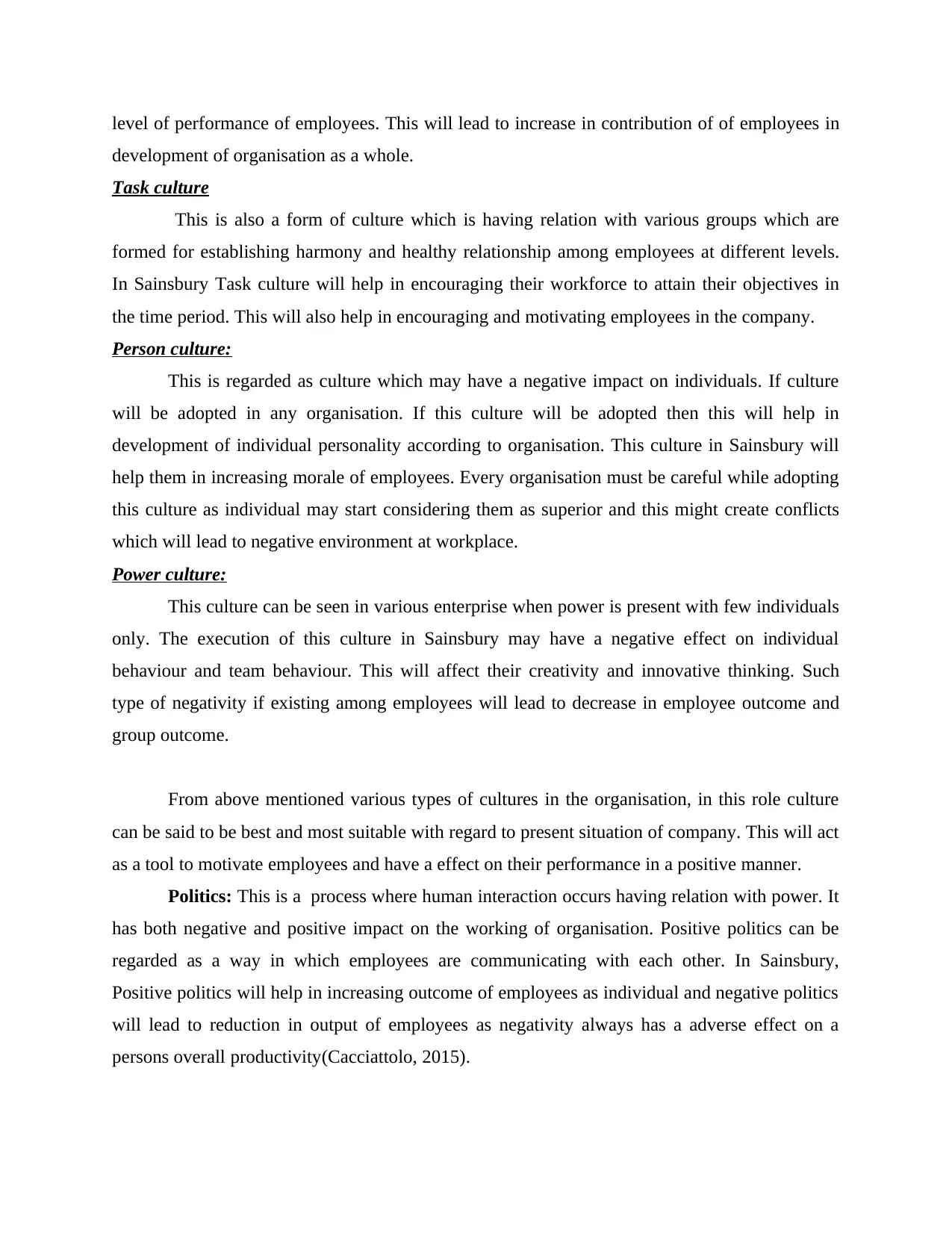
level of performance of employees. This will lead to increase in contribution of of employees in
development of organisation as a whole.
Task culture
This is also a form of culture which is having relation with various groups which are
formed for establishing harmony and healthy relationship among employees at different levels.
In Sainsbury Task culture will help in encouraging their workforce to attain their objectives in
the time period. This will also help in encouraging and motivating employees in the company.
Person culture:
This is regarded as culture which may have a negative impact on individuals. If culture
will be adopted in any organisation. If this culture will be adopted then this will help in
development of individual personality according to organisation. This culture in Sainsbury will
help them in increasing morale of employees. Every organisation must be careful while adopting
this culture as individual may start considering them as superior and this might create conflicts
which will lead to negative environment at workplace.
Power culture:
This culture can be seen in various enterprise when power is present with few individuals
only. The execution of this culture in Sainsbury may have a negative effect on individual
behaviour and team behaviour. This will affect their creativity and innovative thinking. Such
type of negativity if existing among employees will lead to decrease in employee outcome and
group outcome.
From above mentioned various types of cultures in the organisation, in this role culture
can be said to be best and most suitable with regard to present situation of company. This will act
as a tool to motivate employees and have a effect on their performance in a positive manner.
Politics: This is a process where human interaction occurs having relation with power. It
has both negative and positive impact on the working of organisation. Positive politics can be
regarded as a way in which employees are communicating with each other. In Sainsbury,
Positive politics will help in increasing outcome of employees as individual and negative politics
will lead to reduction in output of employees as negativity always has a adverse effect on a
persons overall productivity(Cacciattolo, 2015).
development of organisation as a whole.
Task culture
This is also a form of culture which is having relation with various groups which are
formed for establishing harmony and healthy relationship among employees at different levels.
In Sainsbury Task culture will help in encouraging their workforce to attain their objectives in
the time period. This will also help in encouraging and motivating employees in the company.
Person culture:
This is regarded as culture which may have a negative impact on individuals. If culture
will be adopted in any organisation. If this culture will be adopted then this will help in
development of individual personality according to organisation. This culture in Sainsbury will
help them in increasing morale of employees. Every organisation must be careful while adopting
this culture as individual may start considering them as superior and this might create conflicts
which will lead to negative environment at workplace.
Power culture:
This culture can be seen in various enterprise when power is present with few individuals
only. The execution of this culture in Sainsbury may have a negative effect on individual
behaviour and team behaviour. This will affect their creativity and innovative thinking. Such
type of negativity if existing among employees will lead to decrease in employee outcome and
group outcome.
From above mentioned various types of cultures in the organisation, in this role culture
can be said to be best and most suitable with regard to present situation of company. This will act
as a tool to motivate employees and have a effect on their performance in a positive manner.
Politics: This is a process where human interaction occurs having relation with power. It
has both negative and positive impact on the working of organisation. Positive politics can be
regarded as a way in which employees are communicating with each other. In Sainsbury,
Positive politics will help in increasing outcome of employees as individual and negative politics
will lead to reduction in output of employees as negativity always has a adverse effect on a
persons overall productivity(Cacciattolo, 2015).
Paraphrase This Document
Need a fresh take? Get an instant paraphrase of this document with our AI Paraphraser
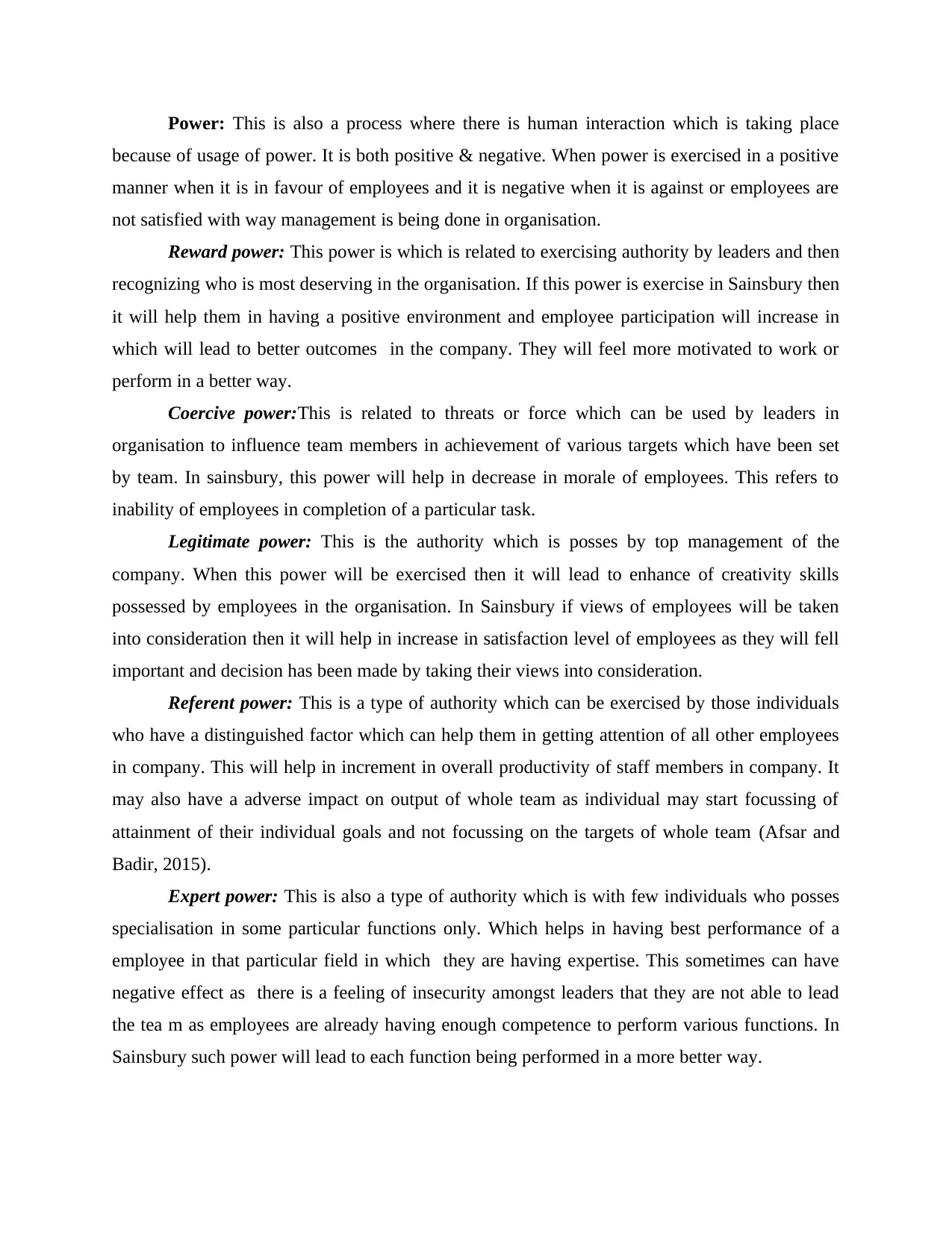
Power: This is also a process where there is human interaction which is taking place
because of usage of power. It is both positive & negative. When power is exercised in a positive
manner when it is in favour of employees and it is negative when it is against or employees are
not satisfied with way management is being done in organisation.
Reward power: This power is which is related to exercising authority by leaders and then
recognizing who is most deserving in the organisation. If this power is exercise in Sainsbury then
it will help them in having a positive environment and employee participation will increase in
which will lead to better outcomes in the company. They will feel more motivated to work or
perform in a better way.
Coercive power:This is related to threats or force which can be used by leaders in
organisation to influence team members in achievement of various targets which have been set
by team. In sainsbury, this power will help in decrease in morale of employees. This refers to
inability of employees in completion of a particular task.
Legitimate power: This is the authority which is posses by top management of the
company. When this power will be exercised then it will lead to enhance of creativity skills
possessed by employees in the organisation. In Sainsbury if views of employees will be taken
into consideration then it will help in increase in satisfaction level of employees as they will fell
important and decision has been made by taking their views into consideration.
Referent power: This is a type of authority which can be exercised by those individuals
who have a distinguished factor which can help them in getting attention of all other employees
in company. This will help in increment in overall productivity of staff members in company. It
may also have a adverse impact on output of whole team as individual may start focussing of
attainment of their individual goals and not focussing on the targets of whole team (Afsar and
Badir, 2015).
Expert power: This is also a type of authority which is with few individuals who posses
specialisation in some particular functions only. Which helps in having best performance of a
employee in that particular field in which they are having expertise. This sometimes can have
negative effect as there is a feeling of insecurity amongst leaders that they are not able to lead
the tea m as employees are already having enough competence to perform various functions. In
Sainsbury such power will lead to each function being performed in a more better way.
because of usage of power. It is both positive & negative. When power is exercised in a positive
manner when it is in favour of employees and it is negative when it is against or employees are
not satisfied with way management is being done in organisation.
Reward power: This power is which is related to exercising authority by leaders and then
recognizing who is most deserving in the organisation. If this power is exercise in Sainsbury then
it will help them in having a positive environment and employee participation will increase in
which will lead to better outcomes in the company. They will feel more motivated to work or
perform in a better way.
Coercive power:This is related to threats or force which can be used by leaders in
organisation to influence team members in achievement of various targets which have been set
by team. In sainsbury, this power will help in decrease in morale of employees. This refers to
inability of employees in completion of a particular task.
Legitimate power: This is the authority which is posses by top management of the
company. When this power will be exercised then it will lead to enhance of creativity skills
possessed by employees in the organisation. In Sainsbury if views of employees will be taken
into consideration then it will help in increase in satisfaction level of employees as they will fell
important and decision has been made by taking their views into consideration.
Referent power: This is a type of authority which can be exercised by those individuals
who have a distinguished factor which can help them in getting attention of all other employees
in company. This will help in increment in overall productivity of staff members in company. It
may also have a adverse impact on output of whole team as individual may start focussing of
attainment of their individual goals and not focussing on the targets of whole team (Afsar and
Badir, 2015).
Expert power: This is also a type of authority which is with few individuals who posses
specialisation in some particular functions only. Which helps in having best performance of a
employee in that particular field in which they are having expertise. This sometimes can have
negative effect as there is a feeling of insecurity amongst leaders that they are not able to lead
the tea m as employees are already having enough competence to perform various functions. In
Sainsbury such power will lead to each function being performed in a more better way.
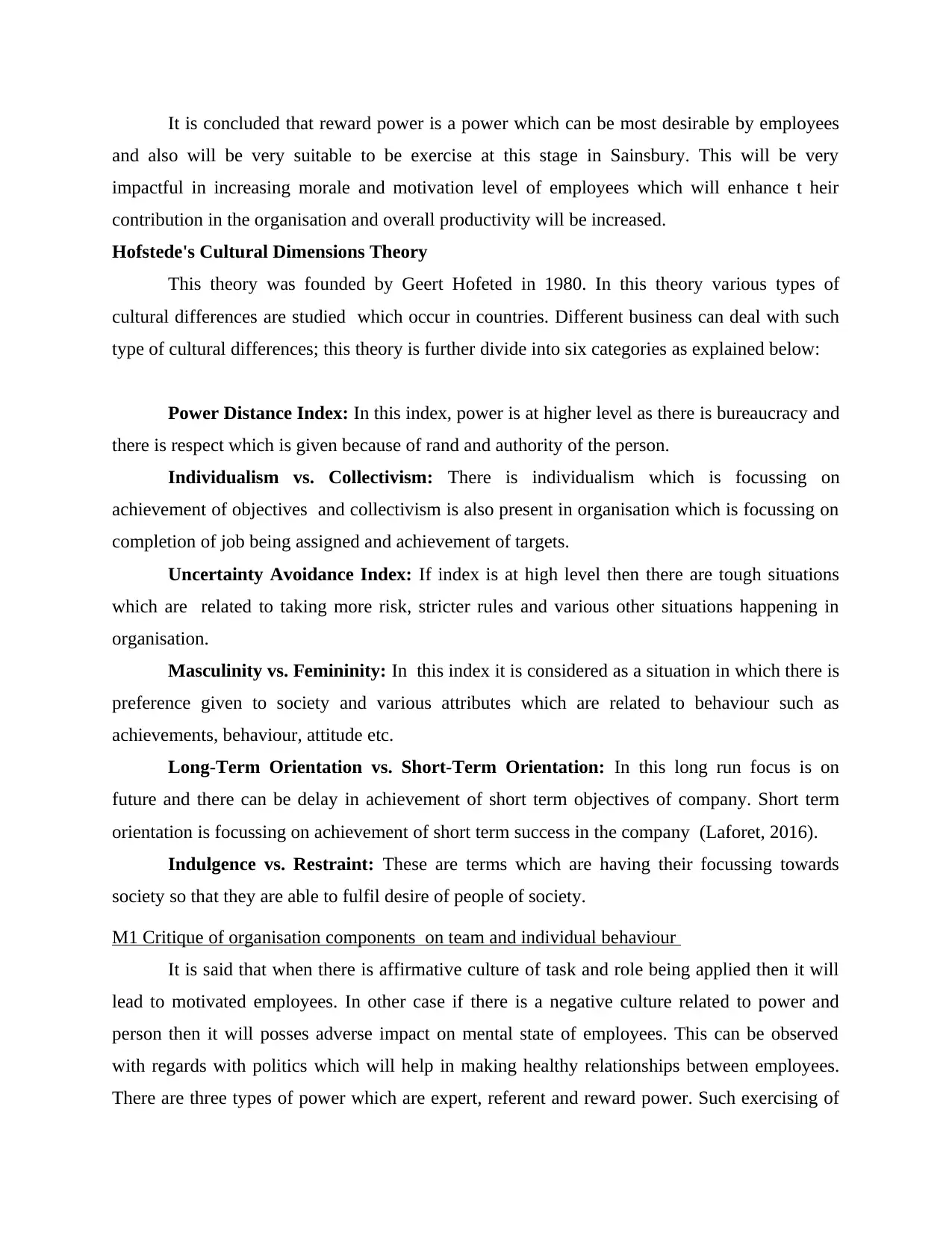
It is concluded that reward power is a power which can be most desirable by employees
and also will be very suitable to be exercise at this stage in Sainsbury. This will be very
impactful in increasing morale and motivation level of employees which will enhance t heir
contribution in the organisation and overall productivity will be increased.
Hofstede's Cultural Dimensions Theory
This theory was founded by Geert Hofeted in 1980. In this theory various types of
cultural differences are studied which occur in countries. Different business can deal with such
type of cultural differences; this theory is further divide into six categories as explained below:
Power Distance Index: In this index, power is at higher level as there is bureaucracy and
there is respect which is given because of rand and authority of the person.
Individualism vs. Collectivism: There is individualism which is focussing on
achievement of objectives and collectivism is also present in organisation which is focussing on
completion of job being assigned and achievement of targets.
Uncertainty Avoidance Index: If index is at high level then there are tough situations
which are related to taking more risk, stricter rules and various other situations happening in
organisation.
Masculinity vs. Femininity: In this index it is considered as a situation in which there is
preference given to society and various attributes which are related to behaviour such as
achievements, behaviour, attitude etc.
Long-Term Orientation vs. Short-Term Orientation: In this long run focus is on
future and there can be delay in achievement of short term objectives of company. Short term
orientation is focussing on achievement of short term success in the company (Laforet, 2016).
Indulgence vs. Restraint: These are terms which are having their focussing towards
society so that they are able to fulfil desire of people of society.
M1 Critique of organisation components on team and individual behaviour
It is said that when there is affirmative culture of task and role being applied then it will
lead to motivated employees. In other case if there is a negative culture related to power and
person then it will posses adverse impact on mental state of employees. This can be observed
with regards with politics which will help in making healthy relationships between employees.
There are three types of power which are expert, referent and reward power. Such exercising of
and also will be very suitable to be exercise at this stage in Sainsbury. This will be very
impactful in increasing morale and motivation level of employees which will enhance t heir
contribution in the organisation and overall productivity will be increased.
Hofstede's Cultural Dimensions Theory
This theory was founded by Geert Hofeted in 1980. In this theory various types of
cultural differences are studied which occur in countries. Different business can deal with such
type of cultural differences; this theory is further divide into six categories as explained below:
Power Distance Index: In this index, power is at higher level as there is bureaucracy and
there is respect which is given because of rand and authority of the person.
Individualism vs. Collectivism: There is individualism which is focussing on
achievement of objectives and collectivism is also present in organisation which is focussing on
completion of job being assigned and achievement of targets.
Uncertainty Avoidance Index: If index is at high level then there are tough situations
which are related to taking more risk, stricter rules and various other situations happening in
organisation.
Masculinity vs. Femininity: In this index it is considered as a situation in which there is
preference given to society and various attributes which are related to behaviour such as
achievements, behaviour, attitude etc.
Long-Term Orientation vs. Short-Term Orientation: In this long run focus is on
future and there can be delay in achievement of short term objectives of company. Short term
orientation is focussing on achievement of short term success in the company (Laforet, 2016).
Indulgence vs. Restraint: These are terms which are having their focussing towards
society so that they are able to fulfil desire of people of society.
M1 Critique of organisation components on team and individual behaviour
It is said that when there is affirmative culture of task and role being applied then it will
lead to motivated employees. In other case if there is a negative culture related to power and
person then it will posses adverse impact on mental state of employees. This can be observed
with regards with politics which will help in making healthy relationships between employees.
There are three types of power which are expert, referent and reward power. Such exercising of
⊘ This is a preview!⊘
Do you want full access?
Subscribe today to unlock all pages.

Trusted by 1+ million students worldwide
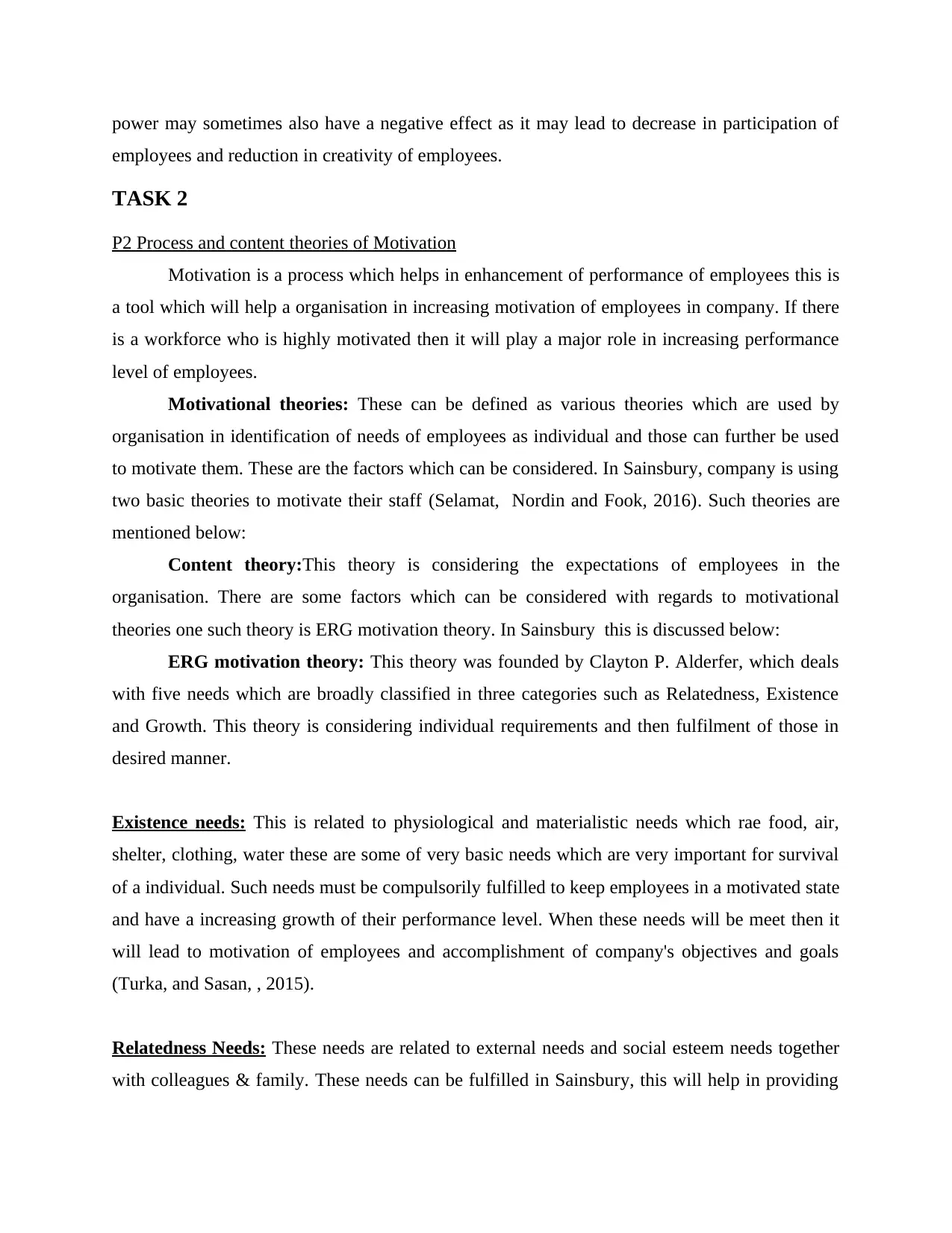
power may sometimes also have a negative effect as it may lead to decrease in participation of
employees and reduction in creativity of employees.
TASK 2
P2 Process and content theories of Motivation
Motivation is a process which helps in enhancement of performance of employees this is
a tool which will help a organisation in increasing motivation of employees in company. If there
is a workforce who is highly motivated then it will play a major role in increasing performance
level of employees.
Motivational theories: These can be defined as various theories which are used by
organisation in identification of needs of employees as individual and those can further be used
to motivate them. These are the factors which can be considered. In Sainsbury, company is using
two basic theories to motivate their staff (Selamat, Nordin and Fook, 2016). Such theories are
mentioned below:
Content theory:This theory is considering the expectations of employees in the
organisation. There are some factors which can be considered with regards to motivational
theories one such theory is ERG motivation theory. In Sainsbury this is discussed below:
ERG motivation theory: This theory was founded by Clayton P. Alderfer, which deals
with five needs which are broadly classified in three categories such as Relatedness, Existence
and Growth. This theory is considering individual requirements and then fulfilment of those in
desired manner.
Existence needs: This is related to physiological and materialistic needs which rae food, air,
shelter, clothing, water these are some of very basic needs which are very important for survival
of a individual. Such needs must be compulsorily fulfilled to keep employees in a motivated state
and have a increasing growth of their performance level. When these needs will be meet then it
will lead to motivation of employees and accomplishment of company's objectives and goals
(Turka, and Sasan, , 2015).
Relatedness Needs: These needs are related to external needs and social esteem needs together
with colleagues & family. These needs can be fulfilled in Sainsbury, this will help in providing
employees and reduction in creativity of employees.
TASK 2
P2 Process and content theories of Motivation
Motivation is a process which helps in enhancement of performance of employees this is
a tool which will help a organisation in increasing motivation of employees in company. If there
is a workforce who is highly motivated then it will play a major role in increasing performance
level of employees.
Motivational theories: These can be defined as various theories which are used by
organisation in identification of needs of employees as individual and those can further be used
to motivate them. These are the factors which can be considered. In Sainsbury, company is using
two basic theories to motivate their staff (Selamat, Nordin and Fook, 2016). Such theories are
mentioned below:
Content theory:This theory is considering the expectations of employees in the
organisation. There are some factors which can be considered with regards to motivational
theories one such theory is ERG motivation theory. In Sainsbury this is discussed below:
ERG motivation theory: This theory was founded by Clayton P. Alderfer, which deals
with five needs which are broadly classified in three categories such as Relatedness, Existence
and Growth. This theory is considering individual requirements and then fulfilment of those in
desired manner.
Existence needs: This is related to physiological and materialistic needs which rae food, air,
shelter, clothing, water these are some of very basic needs which are very important for survival
of a individual. Such needs must be compulsorily fulfilled to keep employees in a motivated state
and have a increasing growth of their performance level. When these needs will be meet then it
will lead to motivation of employees and accomplishment of company's objectives and goals
(Turka, and Sasan, , 2015).
Relatedness Needs: These needs are related to external needs and social esteem needs together
with colleagues & family. These needs can be fulfilled in Sainsbury, this will help in providing
Paraphrase This Document
Need a fresh take? Get an instant paraphrase of this document with our AI Paraphraser

employees recognition so that they are able to develop a sense of competition which will help
them in accomplish vision of the organisation.
Growth Needs: This is related to those individuals who are possessing a personality which is
beneficial for the whole organisation. Sainsbury can fulfil such individual needs by various
training programs, apprenticeship programs which can help in individual training and growth of
their skills. This will also help in enhancement of creative skills of employees in the company.
Process theory:
This theory lays emphasis on whole procedure which will help the organisation in
evolvement of various process which will help in motivation of employees with time (Su, Baird
and Schoch, 2015 ). One such theory which can be used in this context is Adam's equity theory
which is a motivational theory which is explained below:
Adam's equity theory
This theory was founded by John Stacy Adams, which majorly focused on two principles.
First is related to establishing equilibrium in input and output between individuals. Second is
related to personnel whom should have trust on organisation has to be treated in a fair and
equitable manner. Sainsbury, is a company which is a well known brand across world. This is
reason why they highly have preference for creation of policies which are beneficial for
employees such as paid leaves, various certification courses, monetary or non monetary rewards
and various other benefits which are beneficial for employees.
M2 Critique on how behaviour is affected by motivational theories
When motivational theory such as ERG motivation and Adam’s theory Sainsbury will influence
behaviour of individual in a more positive manner (Goh, Ritchie and Wang, 2017). It has
analysed that such characteristic will help in developing individuals in a more positive manner.
Adams equity theory will help in promotion of equality and ERG theory will help in enhancing
motivation level of their personnel.
them in accomplish vision of the organisation.
Growth Needs: This is related to those individuals who are possessing a personality which is
beneficial for the whole organisation. Sainsbury can fulfil such individual needs by various
training programs, apprenticeship programs which can help in individual training and growth of
their skills. This will also help in enhancement of creative skills of employees in the company.
Process theory:
This theory lays emphasis on whole procedure which will help the organisation in
evolvement of various process which will help in motivation of employees with time (Su, Baird
and Schoch, 2015 ). One such theory which can be used in this context is Adam's equity theory
which is a motivational theory which is explained below:
Adam's equity theory
This theory was founded by John Stacy Adams, which majorly focused on two principles.
First is related to establishing equilibrium in input and output between individuals. Second is
related to personnel whom should have trust on organisation has to be treated in a fair and
equitable manner. Sainsbury, is a company which is a well known brand across world. This is
reason why they highly have preference for creation of policies which are beneficial for
employees such as paid leaves, various certification courses, monetary or non monetary rewards
and various other benefits which are beneficial for employees.
M2 Critique on how behaviour is affected by motivational theories
When motivational theory such as ERG motivation and Adam’s theory Sainsbury will influence
behaviour of individual in a more positive manner (Goh, Ritchie and Wang, 2017). It has
analysed that such characteristic will help in developing individuals in a more positive manner.
Adams equity theory will help in promotion of equality and ERG theory will help in enhancing
motivation level of their personnel.

D1 Critique of overall relationship between power, politics , culture and motivation which will
enable a organisational success in justification of recommendations
Application of positive role and task culture with reference to reward, expert and referent,
politics will help in facilitating overall level of performance of employees in company. If these
three elements will have a negative effect then it will affect the overall environment of the
company in a negative manner. Sainsbury will make sure that there are politics, power and
culture present in their organisation so that there is positive impact on motivation level of
employees (Mafabi, Munene, and Ahiauzu 2015).
TASK 3
P3 Effective & Ineffective teams
Teams are those which are accumulation of some individuals who come together and that
formation of group is regarded as a team which is working towards achievement of a common
objective. In every organisation there are basically two types of teams which are effective teams
and ineffective teams. Sainsbury ensure that they are having all teams which are effectively
working towards achievement of their objectives (Brough, Chataway and Biggs, , 2016).
Basis Effective teams Ineffective teams
Achievement of objectives Goals have to be clearly
stipulated and communicated
to all the members of a
particular group so that they
are having required clarity as
to in which directions they
have to work to achieve laid
objectives by their leader.
In such teams objectives are
not clearly defined and there is
a lot of confusion amongst
team members related to what
work has to be done by them
in what manner all operation
will be performed by the team.
Process of decision making Every member in a particular
team participates in the
process of decision making
which makes it very easy for
leader to come to a decision
In case of ineffective teams
leaders do not consider the
view point of all their
members but if they consider
then there are always
enable a organisational success in justification of recommendations
Application of positive role and task culture with reference to reward, expert and referent,
politics will help in facilitating overall level of performance of employees in company. If these
three elements will have a negative effect then it will affect the overall environment of the
company in a negative manner. Sainsbury will make sure that there are politics, power and
culture present in their organisation so that there is positive impact on motivation level of
employees (Mafabi, Munene, and Ahiauzu 2015).
TASK 3
P3 Effective & Ineffective teams
Teams are those which are accumulation of some individuals who come together and that
formation of group is regarded as a team which is working towards achievement of a common
objective. In every organisation there are basically two types of teams which are effective teams
and ineffective teams. Sainsbury ensure that they are having all teams which are effectively
working towards achievement of their objectives (Brough, Chataway and Biggs, , 2016).
Basis Effective teams Ineffective teams
Achievement of objectives Goals have to be clearly
stipulated and communicated
to all the members of a
particular group so that they
are having required clarity as
to in which directions they
have to work to achieve laid
objectives by their leader.
In such teams objectives are
not clearly defined and there is
a lot of confusion amongst
team members related to what
work has to be done by them
in what manner all operation
will be performed by the team.
Process of decision making Every member in a particular
team participates in the
process of decision making
which makes it very easy for
leader to come to a decision
In case of ineffective teams
leaders do not consider the
view point of all their
members but if they consider
then there are always
⊘ This is a preview!⊘
Do you want full access?
Subscribe today to unlock all pages.

Trusted by 1+ million students worldwide

also such teams have a
characteristic that they are not
having any type of conflicts
amongst their members
regarding any conflict of
opinion or thought.
difference in opinion which
leads to a situation that no one
decision is made and high
dissatisfaction amongst all
members of team.
Team Dynamics
Accordance with the theory given by Lencioni's there are major five elements which are
very important for a organisation to take into consideration for making of effective & cohesive
teams those are discussed below:
Trust: All members in organization must possess strong trust for each other this is a key which
can help in laying down effective coordination amongst all employees.
Healthy Conflict: Conflicts arise in every organisation and they cannot be avoided but it can
make sure that there are very less conflicts which are serious are arsing, as healthy conflicts are
not affecting functioning of a company.
Commitment: Every individual must be committed towards achievement of set objectives in the
specifies time period.
Accountability: There are many elements in every organisation and there must be clear
accountability for each member so that they are able to deliver high performance and best results.
Result focussed: The major objective of team is to have clear focus on results which have to be
stipulated in beginning of the work (Corfield and Paton, 2016).
Types of teams
There are different teams which have been made and developed in organisational
according to requirement in organisation. These type are explained below:
Project team: These teams are made with a objective of completing the project in a more
effective way. Sainbury is a brand which is willing to introduce projects with time intervals
which is helping them in executing their work at different stages (Memduhoglu and Yildiz,
2016).
characteristic that they are not
having any type of conflicts
amongst their members
regarding any conflict of
opinion or thought.
difference in opinion which
leads to a situation that no one
decision is made and high
dissatisfaction amongst all
members of team.
Team Dynamics
Accordance with the theory given by Lencioni's there are major five elements which are
very important for a organisation to take into consideration for making of effective & cohesive
teams those are discussed below:
Trust: All members in organization must possess strong trust for each other this is a key which
can help in laying down effective coordination amongst all employees.
Healthy Conflict: Conflicts arise in every organisation and they cannot be avoided but it can
make sure that there are very less conflicts which are serious are arsing, as healthy conflicts are
not affecting functioning of a company.
Commitment: Every individual must be committed towards achievement of set objectives in the
specifies time period.
Accountability: There are many elements in every organisation and there must be clear
accountability for each member so that they are able to deliver high performance and best results.
Result focussed: The major objective of team is to have clear focus on results which have to be
stipulated in beginning of the work (Corfield and Paton, 2016).
Types of teams
There are different teams which have been made and developed in organisational
according to requirement in organisation. These type are explained below:
Project team: These teams are made with a objective of completing the project in a more
effective way. Sainbury is a brand which is willing to introduce projects with time intervals
which is helping them in executing their work at different stages (Memduhoglu and Yildiz,
2016).
Paraphrase This Document
Need a fresh take? Get an instant paraphrase of this document with our AI Paraphraser
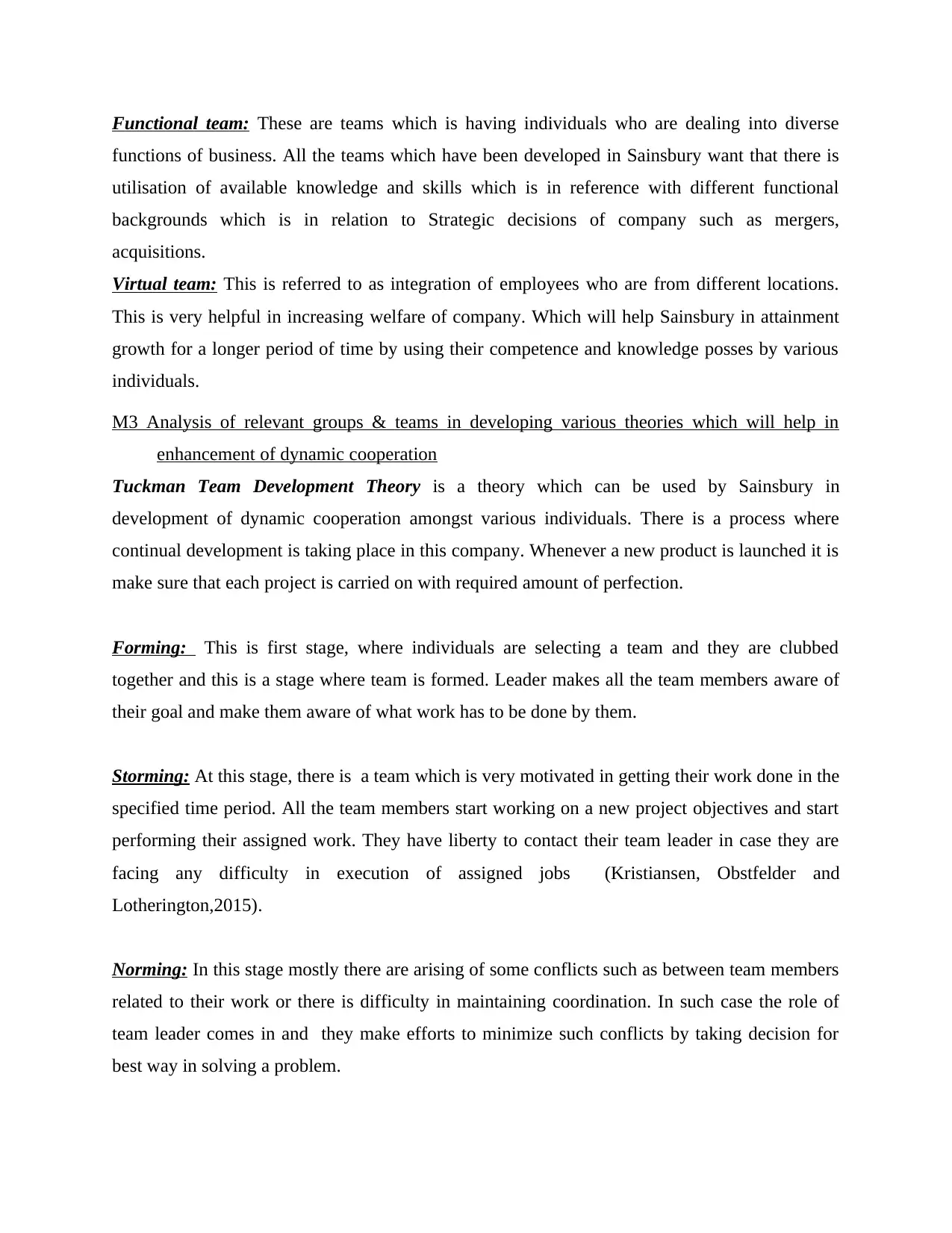
Functional team: These are teams which is having individuals who are dealing into diverse
functions of business. All the teams which have been developed in Sainsbury want that there is
utilisation of available knowledge and skills which is in reference with different functional
backgrounds which is in relation to Strategic decisions of company such as mergers,
acquisitions.
Virtual team: This is referred to as integration of employees who are from different locations.
This is very helpful in increasing welfare of company. Which will help Sainsbury in attainment
growth for a longer period of time by using their competence and knowledge posses by various
individuals.
M3 Analysis of relevant groups & teams in developing various theories which will help in
enhancement of dynamic cooperation
Tuckman Team Development Theory is a theory which can be used by Sainsbury in
development of dynamic cooperation amongst various individuals. There is a process where
continual development is taking place in this company. Whenever a new product is launched it is
make sure that each project is carried on with required amount of perfection.
Forming: This is first stage, where individuals are selecting a team and they are clubbed
together and this is a stage where team is formed. Leader makes all the team members aware of
their goal and make them aware of what work has to be done by them.
Storming: At this stage, there is a team which is very motivated in getting their work done in the
specified time period. All the team members start working on a new project objectives and start
performing their assigned work. They have liberty to contact their team leader in case they are
facing any difficulty in execution of assigned jobs (Kristiansen, Obstfelder and
Lotherington,2015).
Norming: In this stage mostly there are arising of some conflicts such as between team members
related to their work or there is difficulty in maintaining coordination. In such case the role of
team leader comes in and they make efforts to minimize such conflicts by taking decision for
best way in solving a problem.
functions of business. All the teams which have been developed in Sainsbury want that there is
utilisation of available knowledge and skills which is in reference with different functional
backgrounds which is in relation to Strategic decisions of company such as mergers,
acquisitions.
Virtual team: This is referred to as integration of employees who are from different locations.
This is very helpful in increasing welfare of company. Which will help Sainsbury in attainment
growth for a longer period of time by using their competence and knowledge posses by various
individuals.
M3 Analysis of relevant groups & teams in developing various theories which will help in
enhancement of dynamic cooperation
Tuckman Team Development Theory is a theory which can be used by Sainsbury in
development of dynamic cooperation amongst various individuals. There is a process where
continual development is taking place in this company. Whenever a new product is launched it is
make sure that each project is carried on with required amount of perfection.
Forming: This is first stage, where individuals are selecting a team and they are clubbed
together and this is a stage where team is formed. Leader makes all the team members aware of
their goal and make them aware of what work has to be done by them.
Storming: At this stage, there is a team which is very motivated in getting their work done in the
specified time period. All the team members start working on a new project objectives and start
performing their assigned work. They have liberty to contact their team leader in case they are
facing any difficulty in execution of assigned jobs (Kristiansen, Obstfelder and
Lotherington,2015).
Norming: In this stage mostly there are arising of some conflicts such as between team members
related to their work or there is difficulty in maintaining coordination. In such case the role of
team leader comes in and they make efforts to minimize such conflicts by taking decision for
best way in solving a problem.
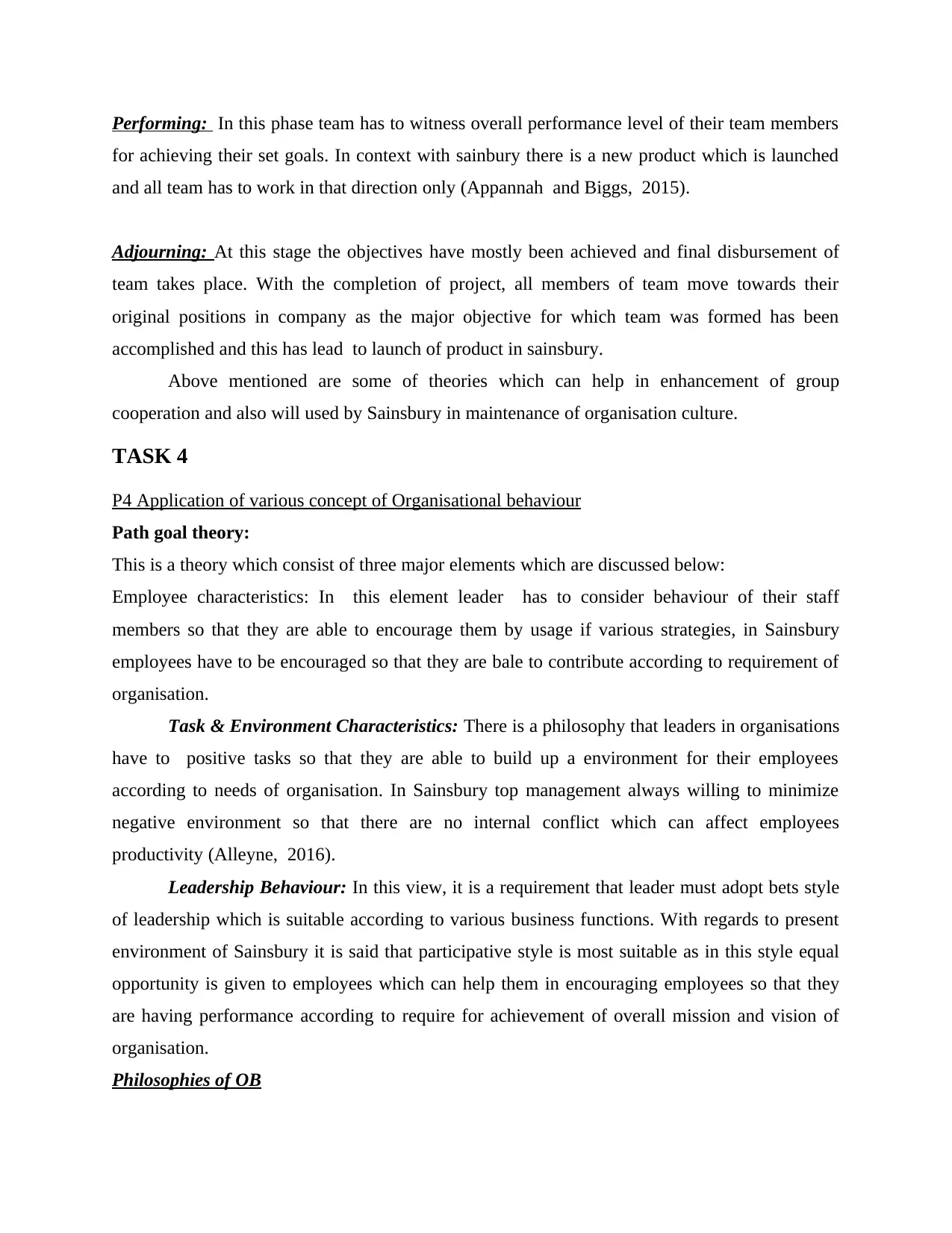
Performing: In this phase team has to witness overall performance level of their team members
for achieving their set goals. In context with sainbury there is a new product which is launched
and all team has to work in that direction only (Appannah and Biggs, 2015).
Adjourning: At this stage the objectives have mostly been achieved and final disbursement of
team takes place. With the completion of project, all members of team move towards their
original positions in company as the major objective for which team was formed has been
accomplished and this has lead to launch of product in sainsbury.
Above mentioned are some of theories which can help in enhancement of group
cooperation and also will used by Sainsbury in maintenance of organisation culture.
TASK 4
P4 Application of various concept of Organisational behaviour
Path goal theory:
This is a theory which consist of three major elements which are discussed below:
Employee characteristics: In this element leader has to consider behaviour of their staff
members so that they are able to encourage them by usage if various strategies, in Sainsbury
employees have to be encouraged so that they are bale to contribute according to requirement of
organisation.
Task & Environment Characteristics: There is a philosophy that leaders in organisations
have to positive tasks so that they are able to build up a environment for their employees
according to needs of organisation. In Sainsbury top management always willing to minimize
negative environment so that there are no internal conflict which can affect employees
productivity (Alleyne, 2016).
Leadership Behaviour: In this view, it is a requirement that leader must adopt bets style
of leadership which is suitable according to various business functions. With regards to present
environment of Sainsbury it is said that participative style is most suitable as in this style equal
opportunity is given to employees which can help them in encouraging employees so that they
are having performance according to require for achievement of overall mission and vision of
organisation.
Philosophies of OB
for achieving their set goals. In context with sainbury there is a new product which is launched
and all team has to work in that direction only (Appannah and Biggs, 2015).
Adjourning: At this stage the objectives have mostly been achieved and final disbursement of
team takes place. With the completion of project, all members of team move towards their
original positions in company as the major objective for which team was formed has been
accomplished and this has lead to launch of product in sainsbury.
Above mentioned are some of theories which can help in enhancement of group
cooperation and also will used by Sainsbury in maintenance of organisation culture.
TASK 4
P4 Application of various concept of Organisational behaviour
Path goal theory:
This is a theory which consist of three major elements which are discussed below:
Employee characteristics: In this element leader has to consider behaviour of their staff
members so that they are able to encourage them by usage if various strategies, in Sainsbury
employees have to be encouraged so that they are bale to contribute according to requirement of
organisation.
Task & Environment Characteristics: There is a philosophy that leaders in organisations
have to positive tasks so that they are able to build up a environment for their employees
according to needs of organisation. In Sainsbury top management always willing to minimize
negative environment so that there are no internal conflict which can affect employees
productivity (Alleyne, 2016).
Leadership Behaviour: In this view, it is a requirement that leader must adopt bets style
of leadership which is suitable according to various business functions. With regards to present
environment of Sainsbury it is said that participative style is most suitable as in this style equal
opportunity is given to employees which can help them in encouraging employees so that they
are having performance according to require for achievement of overall mission and vision of
organisation.
Philosophies of OB
⊘ This is a preview!⊘
Do you want full access?
Subscribe today to unlock all pages.

Trusted by 1+ million students worldwide
1 out of 17
Related Documents
Your All-in-One AI-Powered Toolkit for Academic Success.
+13062052269
info@desklib.com
Available 24*7 on WhatsApp / Email
![[object Object]](/_next/static/media/star-bottom.7253800d.svg)
Unlock your academic potential
Copyright © 2020–2025 A2Z Services. All Rights Reserved. Developed and managed by ZUCOL.




